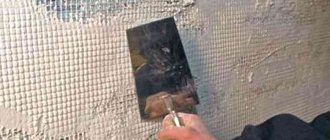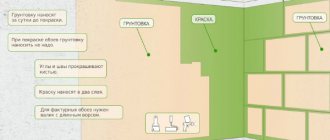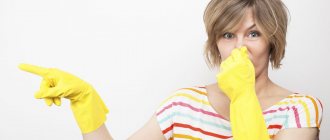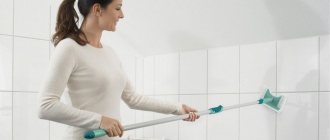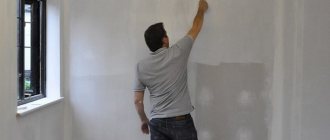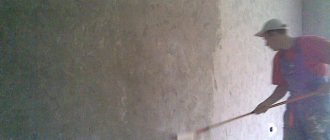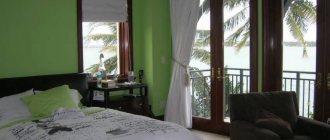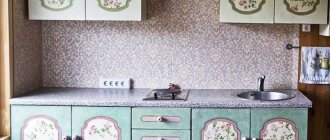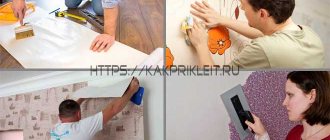Mold covering the walls not only spoils the appearance of the wallpaper, but also harms the health of the people living in the apartment. Therefore, you need to get rid of the fungus immediately as soon as suspicious spots are noticed. It is not at all necessary to tear off the wallpaper and do a major renovation in the room. There are proven folk methods for removing black mold, and household chemical stores sell professional products.
Harm of fungus to health
You can recognize the appearance of fungal colonies in the house by a persistent characteristic odor. Just the sight of unattractive stains on wallpaper causes disgust. You have to completely forget about comfort, since even your clothes are covered with a grayish coating.
When a favorable environment arises in the apartment, several types of fungus appear:
- Green mold forms more often than others and is easy to wash off and destroy.
- Colonies have a dark green tint, which are more difficult to remove, but if you wash them immediately after detection, they do not cause problems.
- The white fungal colony resembles fluff in appearance. Its spores spread very quickly throughout the house and are harmful to health. Such moldy stains can be removed only with a respirator and gloves.
- Black fungal spots weaken human immunity. They cover large areas in a short time. To remove them you need special chemicals.
Important! If more than 20% of the wall surface is affected by fungal colonies, the dwelling is considered dangerous and is considered unsuitable for people and animals to live in.
Mold fungi are dangerous for humans because they provoke allergy attacks, cause dermatological and dental diseases, conjunctivitis and a strong, suffocating cough. Penetrating into the body, mold spores settle on the mucous membranes of the respiratory organs and cause serious illnesses. Long-term living in an apartment contaminated with mold is especially dangerous for children and the elderly. Such proximity causes exacerbation of chronic diseases and becomes the cause of other diseases.
How is mold harmful to humans?
Mold is a type of dangerous microorganism, popularly called simply fungus. These microscopic fungi are very toxic and allergenic. Their spores are practically invisible and therefore doubly dangerous.
Experts treat black mold by exploiting the space, using high-powered fans, and wearing respirators and biosafety suits, usually when occupants leave the home. Controlling the humidity inside your home is key to preventing mold from forming. Check for leaks under sinks and in crawl spaces.
Always use the bathroom vent to remove condensation from the shower. One of the most dangerous mold contamination scenarios is mold contamination inside wall cavities. The simple reason for the severity of this problem is that the shape is not immediately visible to the naked eye and therefore has time to spread over very large areas of the affected building. Residents typically became aware that something was wrong by noticing an increase in symptoms of the unfavorable condition upon entering certain parts of the house.
Mold produces toxic toxins (aflatoxins) that enter the body through the respiratory system and skin.
Accumulating in the body, they will inevitably lead to many diseases:
- allergic;
- bronchial asthma;
- tracheitis, pneumonia;
- constant headaches;
- loss of strength;
- nosebleeds;
- sinusitis;
- aspergillosis;
- weakened immunity;
- skin rashes, etc.
Cavity film can sometimes occur due to water condensation when outside air comes into contact with the cavity side of the cooled interior surface. This is a particular problem when rooms have impenetrable walls such as vinyl wallpaper. These impermeable wall coverings trap moisture between the trim and the drywall. Moisture from outside air naturally passes through the building's outer shell and can condense on the cool adhesive peck. For this reason, vapor barriers should be on the warm side of the wall and should not trap moisture in the wall.
With prolonged exposure, irreversible processes in the body may well begin:
- oncological diseases;
- internal bleeding;
- kidney and liver damage;
- emphysema, etc.
Causes of mold
The fight against mold will be successful only if the cause of its appearance is found out, the source of its spread is detected and destroyed. For the development of a fungal colony, dampness and lack of ventilation are required. This is the main reason for the appearance of mold. But there are several nuances here:
- In modern apartments, windows made of metal-plastic are installed, which do not allow air to pass through at all. In such conditions, mold forms and grows due to lack of fresh air. To prevent its occurrence, windows are periodically opened for ventilation or a special forced ventilation system is used.
- In apartments on the ground floor, the source of mold is the basement, where dampness accumulates. Then the fungus first affects the joints of the walls, and then the entire surface.
- A similar problem arises for residents of the upper floor. But here the source of spread is a leaking roof.
- If black dots on the wallpaper appear in the fall in rainy and cold weather, before the heating is turned on, then the problem is in depressurized interpanel joints, through which dampness penetrates into the apartment.
- Sometimes moldy spots appear immediately after repairs are completed under the wallpaper. In this case, the cause is residual dampness. Therefore, it is better to complete repairs before the onset of cold weather or glue wallpaper after turning on the heating.
- In the bathroom, fungus appears due to simultaneous exposure to high humidity and dampness, which are especially favorable.
- Another reason for dampness and high humidity in the room is the numerous fresh flowers on the windowsill.
In addition to these circumstances, the fungus appears due to unforeseen accidents. The apartment may be flooded by neighbors. Then mold will definitely develop on wet walls if you don’t immediately take care to dry them thoroughly.
Step-by-step steps to combat mold
- We free the walls from the old covering. Moreover, if we are talking about putty that has mold, then it is advisable to pick out the putty, removing everything to the base of the walls.
- We fight dampness and mold. We use specialized liquids to destroy mold and mildew and let the walls dry.
- Leveling the walls. Depending on the condition of your walls, you will need to either plaster or putty them.
- We prime the walls. The primer layer is required to obtain good adhesion.
Methods for detecting mold under wallpaper
It is easy to suspect the presence of mold in an apartment if you constantly smell an unpleasant smell of dampness or mustiness in the basement. In this case, it is worth carefully inspecting the walls. If there are no visible stains on the wallpaper, move the furniture away. Perhaps traces of fungus are hidden behind cabinets and chests of drawers.
Another sign of being around mold is a sudden deterioration in health for no apparent reason. Spores flying around the apartment penetrate the human body and provoke an exacerbation of chronic diseases and allergies.
More often, black spots form in rooms that face the street at an angle. The walls of such a room freeze faster and become damp, giving mold a better chance of survival. Therefore, first of all, they inspect corner rooms that are not used often.
Liquid wallpaper: beautiful options in the interior
There are various design solutions to make liquid wallpaper look as unusual and interesting as possible in both non-standard apartments and ordinary apartments:
- In the living room, products are often combined with other coatings that imitate natural textures, such as stone or wood.
- In a bedroom or nursery, such wall covering can be embodied in a beautiful ensemble with textiles. The use of models with silk elements, which will create a graceful sheen, will add coziness to the room.
- For a child, you can use liquid wallpaper to create a colorful pattern on the wall.
- To create an original interior design, when mixed, glitter or fluorescent paint is added to the wallpaper, creating a stunning shimmer on the wall.
- Liquid wallpaper is not always applied to all the walls in the room. They can play an accent role and be located only on one wall. They should be consistent in color with the rest of the walls, but stand out among them with their unusual texture.
- The mixture is used to fill areas on a relief wall, for example, in the space under an arch.
The obvious fact is that liquid wallpaper has many more positive aspects than negative ones. Feel free to choose similar products to decorate your apartments. Looking at the original appearance of the walls, you will receive aesthetic pleasure and experience joy while at home.
To learn how to apply liquid wallpaper to a wall, see the following video.
Ways to stop the infection
After detecting mold and finding out the cause of its appearance, it is important to create conditions in the apartment that are unsuitable for further growth of the fungus. Otherwise, all measures taken to combat the colony will be useless.
You need to follow these steps to ensure that the fungus under the wallpaper no longer spreads:
- They get rid of all sources of dampness: hang wet laundry to dry on the balcony or outside, eliminate all faults in the plumbing, and install an extractor hood in the kitchen.
- In the summer, open all the windows in the house completely to let in more fresh air and sunlight. In winter, to improve circulation, install a fan in the bathroom that sucks in moist air.
- Warm up fungus-infected areas on the wallpaper with a quartz or ultraviolet lamp.
- They dry the air in the room with heaters and a hair dryer to reduce humidity and create a temperature that is destructive for mold.
Important! Only after creating harmful conditions for mold in the apartment do they begin work to eliminate it.
Is it necessary to treat walls against fungus before renovation?
Regarding the need for treatment with fungicidal agents, most experts give a positive answer. The risk of infection is also high in rooms with unfavorable living conditions for microscopic aggressors. Dampness can form, for example, due to flooding by neighbors, leaking radiators, or careless watering of indoor plants.
Thousands of pathogenic microorganisms enter apartments and houses every day - on the soles of shoes, with gusts of wind from windows and vents, on pets, so the risk of mycelium development is high. In the case when the vital processes of fungi occur under the wallpaper, the problem is not noticed for a long time, and when detected, it requires serious efforts to eliminate it.
Mushrooms are one of the most unpretentious living creatures on the planet. For successful development, they only need warmth and humidity, and any materials, including plaster, are suitable for their habitat.
How to get rid of mold on wallpaper
In order not to waste time, before cleaning mold from wallpaper, assess the degree of penetration of the fungus. To do this, in places with the greatest accumulation of stains, lift a part of the canvas and inspect the condition of the wall. If the plaster has darkened, become stained, or its structure is damaged, the fungus has managed to destroy it. Then you shouldn’t start cleaning the wallpaper; the mold that has eaten into the wall will still manifest itself after a while.
If the wall surface is in good condition, the wallpaper can still be saved. The procedure is largely determined by the type of coating.
Cleaning non-woven or acrylic wallpaper
Such fabrics are resistant to abrasion and can successfully withstand moderate exposure to moisture. But high temperatures easily damage them. Therefore, such wallpaper can be cleaned of mold stains by any means, as long as you do not rub it too intensely.
Cleaning mold from paper wallpaper
This coating is inexpensive, so if mold is detected, the easiest way is to remove the sheet and glue a new strip. In addition, there is a high probability that not all dark spots will disappear without a trace. Such coatings can only be cleaned using a dry method; they will likely tear from exposure to moisture.
The wallpaper is dried well using a hair dryer or simply ironed. After the canvas has dried, the black marks are wiped off with a soft brush. Under the peeled canvases, the walls are thoroughly cleaned and the strip is glued in place. After the glue has dried, the sheet is ironed again.
Important! You won’t be able to remove mold yourself if large areas are contaminated.
In this case, the best answer to the question of what to do with the fungus is to call the SES.
How to remove mold from wallpaper using folk remedies
If the fungal lesions are small, you can effectively fight mold with folk remedies.
Usually several sequential treatments are required. Among the well-known folk remedies, it is recommended to use the following:
- Baking soda is the easiest way to clean mold; it is inexpensive and non-toxic. To prepare the solution, stir 1 tsp in 1 glass of warm water. powder. Use this liquid to gently wash the black spots on the wallpaper. The results of this treatment last a long time.
- Table vinegar is used undiluted in combination with soda. First, apply a mixture of soda and water to the stains with a sponge. Then spray vinegar from a spray bottle. After waiting a few minutes for the reaction to pass, wipe off the remaining stains with a wet sponge and ventilate the room to eliminate the pungent odor.
- Hydrogen peroxide has good disinfectant properties, but is odorless. Therefore, it is used to disinfect living rooms. The product wipes stains without additional treatment.
- Ammonia also has good disinfectant properties. It is diluted in the same ratio with water and the stains are washed with the liquid. Less commonly, copper sulfate diluted with water is used for treatment.
- Laundry soap is ground on a grater and made into a paste with the addition of water. Then the product is generously applied to the stains, and after 10 minutes, washed off with water.
- Chlorine bleach is also a good way to remove mold. They are diluted with water in a ratio of 1:10 and the darkened areas on the wallpaper are washed.
Important! When working with chlorine bleach, take into account that this substance can damage the decorative layer of the coating and emits a specific odor.
Application of professional chemicals
After cleaning the mold on the wallpaper in the apartment, instead of folk remedies, you can use special chemicals. Such products are sold in construction and hardware stores or on the market.
The fungicidal solution effectively eliminates fungus. It is mixed with water according to the instructions on the package and the walls are treated. To prevent the recurrence of mold, the product is applied to all surfaces, and not just where stains were found. The drugs Xiolate and Phytoline have a similar effect.
When the treated surface dries, the walls are additionally coated with an antiseptic. This will improve the result and prevent the formation of moldy spots in the future.
It is important to be careful when working to remove mold from wallpaper. To prevent spores from getting on the skin and mucous membranes of the respiratory organs, wear a respirator, rubber gloves and completely cover all parts of the body with clothing.
When working with vinegar and products containing chlorine, avoid contact with skin and mucous membranes to avoid severe burns. It is also important to remember that chlorine and hydrogen peroxide have bleaching properties. Therefore, they can only be used on light-colored surfaces.
After finishing work, protective clothing is removed and washed immediately. Glasses and gloves are wiped with a solution of baking soda or any antifungal agent.
What and how to treat the walls before wallpapering
Without appropriate preparation, high-quality wall finishing is impossible. If your plans for the future do not include the item “do repairs every year,” then the issue of wall treatment should be taken very seriously.
Regardless of the quality of the wallpaper, what material it is made of and how much it costs, they require a properly prepared surface.
Therefore, all the time, effort and resources spent on leveling, priming and puttying the walls will pay off in the future with interest.
The requirements for the wall surface intended for wallpapering are as follows:
- the surface must be dry. When wallpapering, the wall absorbs moisture contained in the adhesive solution, but a wet surface will not absorb anything. To check the condition of the surface, you can glue a piece of cellophane with tape overnight. If droplets of dew appear under it in the morning, then the room needs to be ventilated and dried.
- clean and monochromatic. Stains may show through the wallpaper, ruining its appearance. Therefore, it is necessary to get rid of dirt and prime the surface;
You can find out whether stains will show through the wallpaper by examining the canvas against the light. If the wallpaper is transparent and has veins, then the defect will certainly be visible. If the wallpaper is thick and heavy, then the stains will not be visible.
- durable. If the wall is crumbling and peeling, then the wallpaper will soon begin to peel off. It’s very easy to check the strength; you can use your fingernail, key, coin and run it across the work surface. If there are no traces left, then the condition is satisfactory;
- no limescale stains. The danger of such a defect is that these areas do not absorb moisture. As a result, swelling of the wallpaper occurs. You can check such places using litmus paper. If the alkalinity is increased, a reaction will occur.
- absence of mold and mildew. Such a defect not only looks bad, but also has a bad effect on health. To prevent a “new pattern” from appearing on the wallpaper, you need to carefully treat the affected areas with an antifungal primer.
To fulfill all these requirements, you need to carry out only three stages to prepare the walls for wallpapering:
- Dismantling or removing old wallpaper;
- Plastering walls;
- Puttying the surface.
The first stage is dismantling the old layer of wallpaper. You need to get rid of it and under no circumstances glue a new layer on top of the old wallpaper.
This cannot be done, because the previous layer may simply not withstand the weight of the new wallpaper, and everything will slide off the wall at once.
On the surface of the new wallpaper, after the glue has dried, the pattern that adorned the previous layer will most likely appear, and all this will be covered with wrinkles and bubbles.
It is recommended to dismantle the plinth, but there are cases when it is not rational to do this, for example, if the plinth is wooden and there is a risk of breaking it.
The sockets must be de-energized, the chandelier removed, the radiators, window sills and floors covered with thick polyethylene.
How to treat walls against mold before wallpapering: popular antifungal agents in photographs.
Mold on walls and other surfaces not only spoils the appearance of the room, but also poses a danger to the health of residents. It is especially harmful to children, so timely removal and preventive measures are required. Before you treat the walls against mold before wallpapering, you need to find out about the main reasons for this problem.
Signs of mold
As for human health, the main symptoms are: decreased concentration, feeling tired, regular headaches, and fatigue.
Reasons for appearance
Primers for mineral surfaces
It is easier to prevent any problem, so antifungal treatment of walls is a mandatory process that is carried out at the preparatory stage of finishing. There are several formulations that have gained popularity among domestic users.
Milkill
It is a latex-based emulsion. The active ingredient is a biocide that effectively destroys most types of mold and fungi. It is used as a preventative before finishing concrete, brick and other similar surfaces.
Polymer-based antifungal primer gives good, and most importantly, long-term results
You can work with the substance only at temperatures from 5 to 30 degrees. The material is prone to delamination, so it must be thoroughly mixed before starting work.
Acryl Grundierung
This antifungal agent is a deep penetration acrylic primer. In addition to the antiseptic function, it also increases adhesion to the applied finishing material. Suitable for treating stone surfaces for painting, plastering, etc.
Acrylic-based antiseptics have an optimal price-quality ratio
Shimmelstopp Dufa
This primer is different from all the others. Such wall treatment products are used as additives in paintwork materials or plaster mixtures. The composition provides long-term surface protection against fungi, mold and algae.
After adding the product, you need to thoroughly stir the solution. It can only be applied to a dry and clean surface.
The Dufa brand produces a wide range of high-quality protective compounds for various surfaces
Mixonit GR43
This composition is also used as an additive, but only in dry construction mixtures. Excellent for treating mineral surfaces with good liquid absorption.
Additive for dry mixes “Mixonit GR43” provides a high level of protection against fungus throughout the entire service life of the facing material
Antifungal agents for wood
Wood is most susceptible to mold formation, so antifungal agents must be used to treat it.
Dufa-Holzlasur
This material is a glaze used to restore old and protect new wood products. The coating does not allow water to pass through, which is necessary for the development of fungi.
Dufa-Holzlasur azure is of high quality, but due to the presence of harmful impurities in its composition, it is used only for outdoor work
Baramon S30
This composition is applied to a wooden surface and left to dry. After a certain time, the product crystallizes and becomes indelible. This means that wooden surfaces will be protected from moisture throughout their entire service life and mold will never appear under the wallpaper.
The main advantages of the fungicide “Boramon C30” are its price and lack of odor, but the composition dries for a long time
Pinotex Base
It is an alkyd-based antiseptic. Used for finishing facades, interior walls, fences and other wooden products before painting or wallpapering.
The products are of high quality, but when choosing an antiseptic for wallpaper, you should make sure that this composition is approved for use in indoor residential premises
Folk remedies
Of the folk remedies for long-term protection of walls from harmful microflora, the most effective are “Borax” and “Copper sulfate”; all other compositions are good only for cleaning contaminated surfaces
Rules of application
When choosing a fungus and mold remover, it is recommended to consult with the seller. You need to tell him about the type of coating and the intensity of the damage, only in this way will an inexperienced person be able to purchase a suitable composition.
Repairs will definitely need to be done, but before doing this, it is recommended to determine the cause of the mold. Maybe the new plastic windows are too tight, or problems arose during construction or renovation, in any case, now the goal is to defeat the fungus and stick new wallpaper.
If even a small area of contamination remains on the surface, then after a while you will have to treat the walls, starting the whole process all over again.
In order to remove mold, you need to stock up on the following products:
- be sure to have your own safety equipment, which includes protective clothing, gloves, a respirator or a gauze bandage - fungal mold is toxic to people;
- putty knife;
- a special solution to completely rid the walls of infection;
- solution for antiseptic treatment;
- sponge;
- sandpaper.
We invite you to familiarize yourself with the Glass for the socket - Boxes for sockets and switches (Socket boxes). Types and installation
You need to start treating the walls before gluing the wallpaper with a spatula: with its help you can penetrate well into the infected layer and completely remove it.
A common but wrong move is to get rid of mold with soapy water. If the fungus has existed for a long time, you will have to remove a whole layer of plaster. Special efforts may not be needed, because these places are wet.
After this, all places should be cleaned with sandpaper.
The walls will need to be treated with mortar. There are only two options: either make the solution at home, or purchase a ready-made one. There are many excellent products in hardware stores, and it is enough to dilute the fungicidal solution, following the instructions, and get to work.
The procedure for impregnating the walls can take about 6 hours, but in order to be sure to get rid of fungus or mold before wallpapering, you will need to apply the solution to the walls several times.
The surface is also impregnated with a special, ready-to-use primer with antiseptic properties. To apply it, use a sprayer or a wide brush, covering a dry surface and leaving it to soak for 6 hours.
Mold Prevention
To prevent mold from appearing again after work has been done, it is important to maintain good air circulation in the apartment. To do this, improve the ventilation system or regularly ventilate the home. When preparing food, be sure to use a hood. This will prevent steam from settling on the wallpaper and forming a breeding ground for mold.
A supply ventilation system is installed on plastic windows. This will prevent condensation from settling on the structure by adjusting the air flow. The slopes on the windows are made of plastic or coated with paint with water-repellent properties.
Furniture is not moved close to the walls, leaving a gap of 2-3 cm to improve circulation. If the slightest signs of dampness appear, work is immediately carried out to eliminate it in order to prevent the spread of mold.
Why is it dangerous?
Mold is dangerous to any surface it touches. Food products affected by fungus should not be eaten. Wooden objects and buildings can be destroyed almost entirely by mold; Previously, oak houses, where the floor was affected by mold, were burned so that neighboring buildings would not be damaged. People staying in a room affected by mold are exposed to harmful substances.
For living organisms
Mold harms all living organisms; it is also dangerous for human health, since when it enters the body it leads to the development of intoxication and allergies. Children, elderly people and those whose bodies are weakened due to illness or decreased immunity are especially affected. The impact of fungi on humans occurs through inhalation of spores, due to contact with skin, as well as through consumption of foods spoiled by mold.
When spores come into contact with the skin, allergic reactions occur. Infection of the mucous membranes with mold spores leads to the appearance of a chronic runny nose and dry cough, and the eyes may become inflamed. The fungus can cause asthmatic attacks and diseases of the cardiovascular system, joint-rheumatic complex.
For materials and building structures
A mold colony can develop on almost any material - wood, concrete, brickwork, paint. The fungus not only spoils the appearance with unsightly spots of different shades, but also corrodes the surface, and the speed at which the base deteriorates depends on the material and environmental humidity. Wooden objects and structures can turn into dust in a few months.
